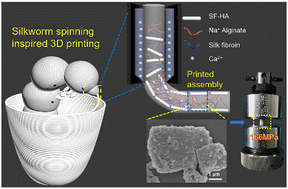Silkworm spinning inspired 3D printing toward a high strength scaffold for bone regeneration†
Abstract
Inspired by the silkworm spinning process for production of tough cocoons, a gradient printing-assembly technique with silk fibroin (SF) and hydroxyapatite (HA) to achieve high strength scaffolds for bone regeneration is developed. A coaxial extrude-nozzle is employed to provide gathered thickening and shearing for aligned assembly. The aligned SF–HA assembles into the compacted nanostructure, which performs a maximum compressive strength of 166 MPa and bending strength of 40 MPa. Scaffolds with various morphologies could be arbitrarily constructed via extruded 3D printing for the regeneration of cortical bone or cancellous bone. The hemolysis quantification of red blood cells (RBCs), proliferation and flow cytometry of bone marrow stem cells (BMSCs) have proved the excellent biocompatibility of the printed scaffolds. Osteogenic induced differentiation assay in vitro and surgical intervention for rat femoral defect repairing have verified the successful osteogenesis with high mechanical strength and remarkable stability in the physiological environment. The silkworm spinning inspired 3D printing offers a facile approach for the fabrication of implantable scaffolds with high strength and excellent biocompatibility, which is highly desired for the applications of bone tissue engineering.



 Please wait while we load your content...
Please wait while we load your content...